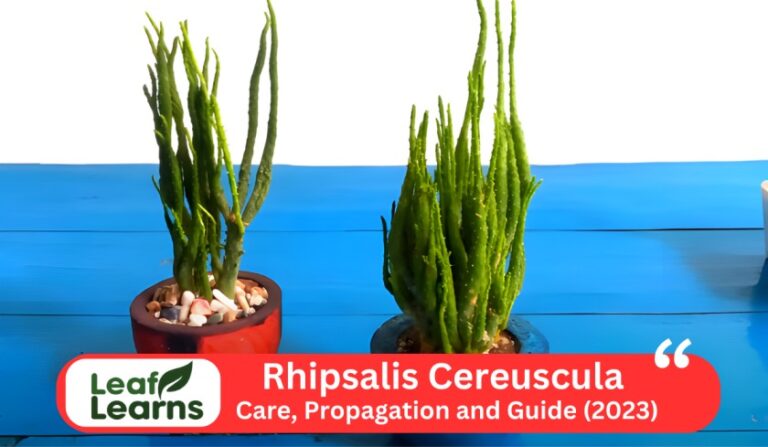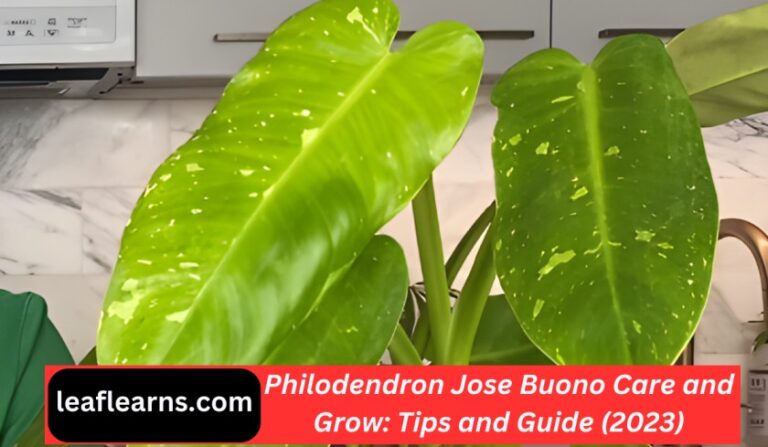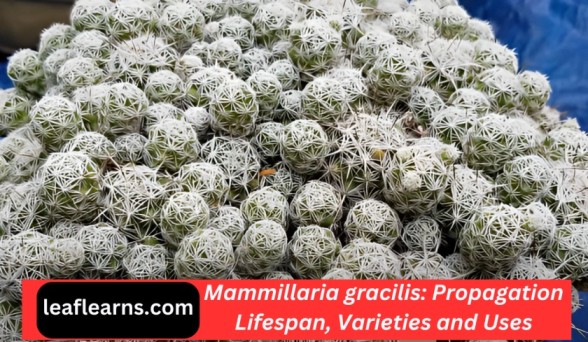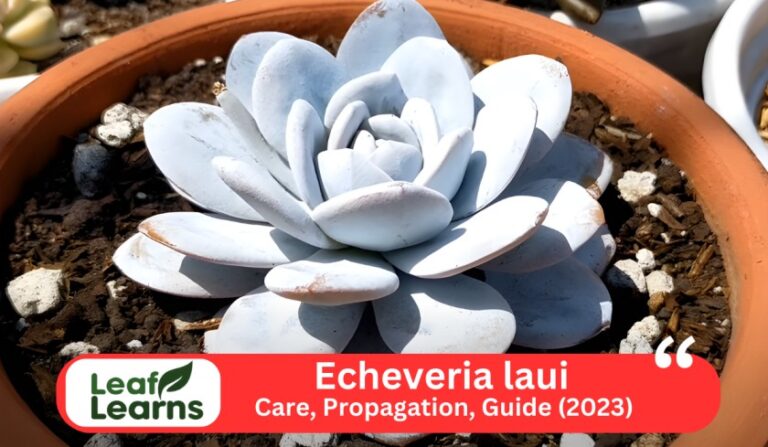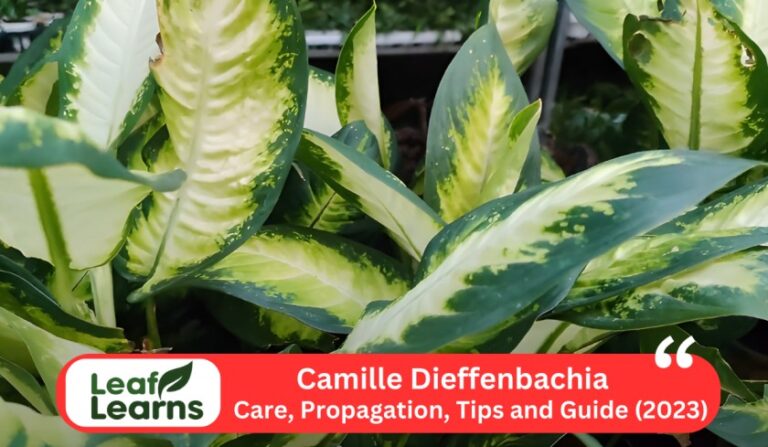Calathea Beauty Star Care Guide (2024)
The Calathea Beauty Star, the star of houseplant with its stunning leaves, shows off its brilliant foliage. Lush, attractive dark stripes extends across the green of the leaves, whilst those leaves are delicately touched with pink and silver mixed with cream. This mesmerizing collection, resembling a haven of serenity and tropical flavors, is guaranteed to make any indoor space a paradise.
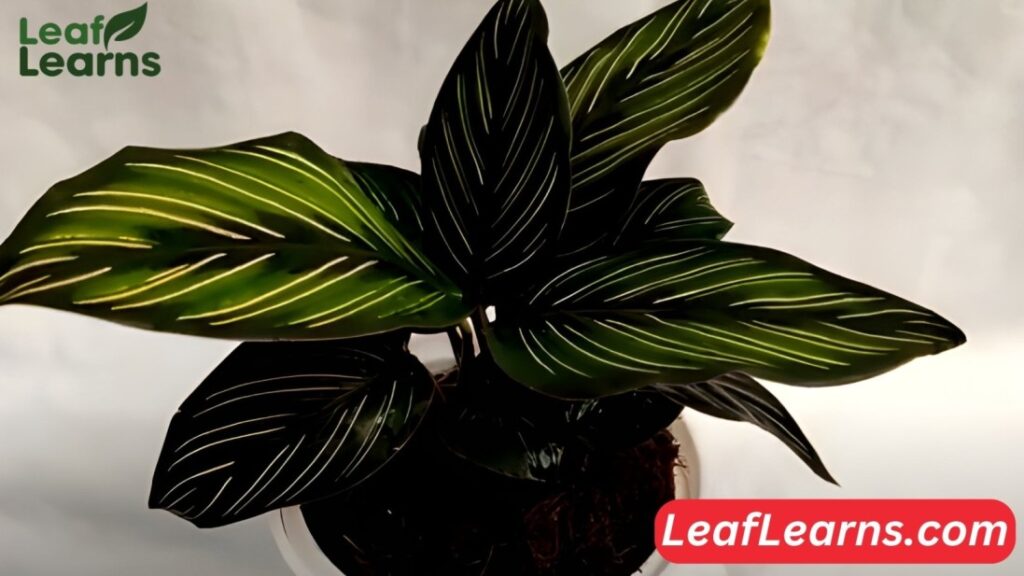
Yet, the Beauty Star’s mythical appeal surpasses just its remarkable beauty. Unlike most flowering plants that adorn houses for they need sunlight, it performs better in low-light conditions which makes it fit for most indoor spaces. In addition to that, its air-refreshing abilities result in a purer air and a more pleasant environment.
| Feature | Description |
| Common Name | Beauty Star Calathea, Beauty Star Prayer Plant |
| Scientific Name | Calathea ornata ‘Beauty Star’ (sometimes listed as Calathea insignis) |
| Family | Marantaceae |
| Origin | Tropical rainforests of South America |
| Plant Type | Evergreen perennial |
| Size | Grows up to 12-18 inches (30-45 cm) tall and 16-24 inches (40-60 cm) wide |
| Lifespan | Several years with proper care |
| Leaf Colour | Light green background with darker green stripes, pinkish-red edges, and silver and cream accents. Underside is deep purple. |
| Flower | Insignificant, small white flowers may appear but are not a main feature. |
| Light | Bright, indirect light. Avoid direct sunlight. |
| Water | Keep soil consistently moist, but not soggy. Allow top inch of soil to dry before watering again. |
| Soil | Well-draining, well-aerated potting mix rich in organic matter. |
| Temperature | Ideal range: 65-80°F (18-27°C) |
| Humidity | Prefers high humidity (50-60%). Use a humidifier, pebble tray, or group plants together. |
| USDA Zone | Not applicable to indoor plants |
| Fertilizer | Weakly balanced liquid fertilizer during spring and summer. |
| Propagation | Division or stem cuttings in spring or summer. |
| Pruning | Remove brown or damaged leaves to encourage new growth. |
| Pests | Spider mites, mealybugs, and scale. Treat with insecticidal soap or neem oil. |
| Toxicity | Non-toxic to humans and pets. |

Contents
- 1 Calathea Beauty Star Care
- 2 Calathea Beauty Star Propagation
- 3 Pruning
- 4 How do you repot a Beauty Star Calathea?
- 5 Calathea Beauty Star Size and Growth Rate
- 6 Flowering and Foliage
- 7 Appearance and Fragrance
- 8 Underwatering And Overwatering
- 9 Common Pests and Diseases
- 10 Is Calathea Beauty Star toxic to cats and pets?
- 11 Varieties/Types
- 12 Calathea Beauty Star Uses
- 13 Essential Care Steps for Calathea-Beauty Star
- 14 FAQs
- 14.1 How do you take care of a Calathea beauty star?
- 14.2 Is Calathea Beauty Star a prayer plant?
- 14.3 What is the common name for Calathea beauty star?
- 14.4 Is Beauty Star Calathea indoor or outdoor?
- 14.5 What is the best soil for Beauty Star Calathea?
- 14.6 How big does Calathea beauty star grow?
- 14.7 Is Beauty Star Calathea easy to care for?
- 14.8 Calathea beauty star leaves turning yellow?
- 14.9 Calathea Beauty star leaves turning brown?
Calathea Beauty Star Care
Calathea Beauty Star light requirement
Give it strong, indirect light to mimic its jungle home. Steer clear of intense, direct sunlight since it may burn the foliage. Windows facing north or east are the best orientations.
How often do you water Beauty Star Calathea?
Keep the soil consistently wet, but don’t let it get soggy. In between waterings, let the top inch of soil to dry. Tap water can lead to mineral build-up, so wherever feasible, use filtered or rainfall.
Calathea Beauty Star Soil Requirement
Select an organic matter-rich, well-draining, aerated potting mix. For best drainage and aeration, a mixture of peat moss, orchid bark, and perlite is used.
Temperature Requirement
A pleasant temperature of 65–80°F (18–27°C) is the goal. Stay clear of drafts and abrupt temperature changes as these may cause stress to the plant.
Do Beauty Star Calathea like humidity?
Plants thrive in humidity levels between 50% and 60%. For a more humid atmosphere, group plants close, use a pebble tray, or acquire a humidifier.
How often should I fertilize my Beauty Star Calathea plant?
Once a month throughout the growing season (spring and summer), apply a liquid fertilizer that is slightly balanced. As directed on the packaging, dilute the solution to prevent over fertilization.
Potting Requirement
In order to avoid water logging, choose a pot with drainage holes. Choose a container that is just a little bit bigger than the root ball so that healthy development may occur without the need for excessive soil storage.
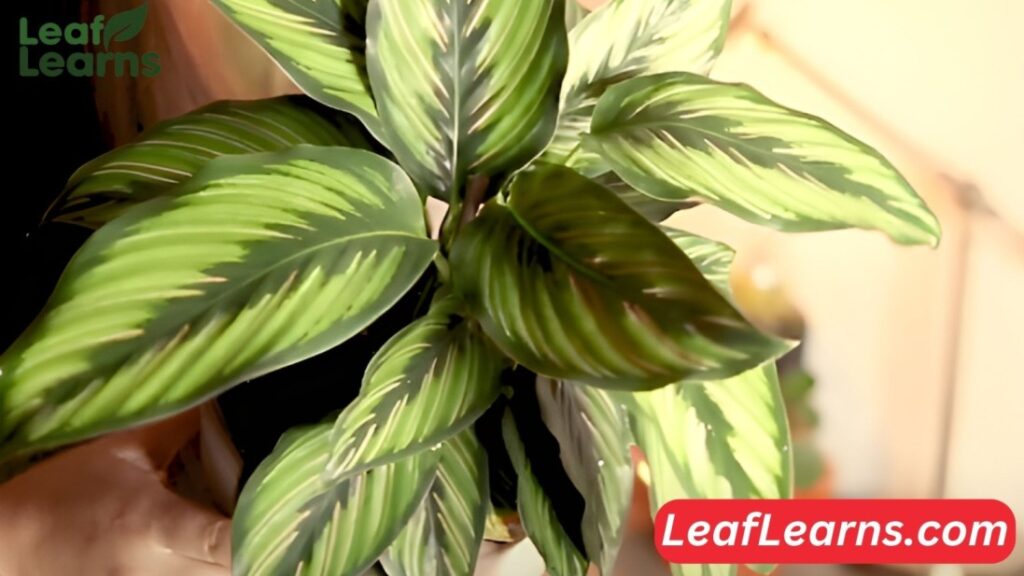
Calathea Beauty Star Propagation
The two major techniques of effectively propagating the Beauty Star Calathea, which is prized for its fascinating leaf, are division and stem cuttings. When the plant is actively developing, in the spring or summer, these techniques work well.
Propagation by Division
- Preparation: To lessen transplant shock, give your Beauty Star Calathea plenty of water 24 hours before division. Remove the plant from its pot with care.
- Division: Using sterile instruments, carefully remove the rhizomes (underground stems). At least two to three healthy leaves and a piece of the root system should be present in each division.
- Potting: Repot each division using aerated, well-draining potting mix in separate pots. Make sure to water well and keep the moisture level constant.
- Aftercare: Put the freshly split plants in a warm, humid spot with indirect, bright light. Frequent misting is advised, and new growth should be observed.
Propagation by Stem Cuttings
- Pick robust stems with two to three nodes (leaf junctions) at a minimum. Cut cleanly with sterilized shears, immediately below a node.
- To prepare for photosynthesis, remove the lower leaves, leaving two to three leaves at the top. To promote the growth of roots, dip the cut end into the rooting hormone (optional).
- Planting: Place the cutting in a container with a potting mix that is wet and drains well. To simulate a little greenhouse, place a transparent plastic bag or cloche over the pot.
- Aftercare: Keep the soil consistently wet and place the container in bright, indirect light. To stop the rot, stay out of direct sunlight and make sure you have enough ventilation.
- Rooting: If the cutting has successfully rooted, new growth should appear from its base within a few weeks. Remove the plastic covering gradually, and go on with regular plant maintenance.
Pruning
For the Beauty Star Calathea to keep its gorgeous look, hardly much pruning is needed. But in order to encourage healthy development, it is imperative that damaged or discolored leaves be regularly removed. How to do it is as follows:
- Determine: Regularly check your plant for sick, wilting, or discolored leaves.
- Cut: Remove the afflicted leaves at the base of the main stem using sharp, sterilized pruning scissors.
- Clean: To stop the spread of illness, give your pruning shears a thorough disinfection after each use.
How do you repot a Beauty Star Calathea?
Repotting is necessary every 1-2 years or when the plant becomes rootbound, indicated by roots emerging from the drainage holes. Here’s a step-by-step guide:
- Preparation: Select a pot with sufficient drainage holes that is just 1-2 inches bigger than the existing one. Make sure your potting mix has plenty of organic materials and drains adequately.
- Removal: Take the plant out of its present pot gently. Carefully loosen any roots that are tightly knotted.
- Repotting: Set the plant in the fresh container, making that the base rests at the same height as the original. The fresh potting mix should be added to the empty area, carefully compacting it around the roots.
- Watering: After repotting, give your plants a good soak, letting any extra runoff drain down. In the next weeks, as the plant settles into its new location, don’t overwater it.
Calathea Beauty Star Size and Growth Rate
This plant grows 2-4 inches in height per year, which is a somewhat modest rate of growth. At maturity, it grows to be 16–24 inches broad and 12–18 inches tall, making it a manageable and compact houseplant for a variety of settings.
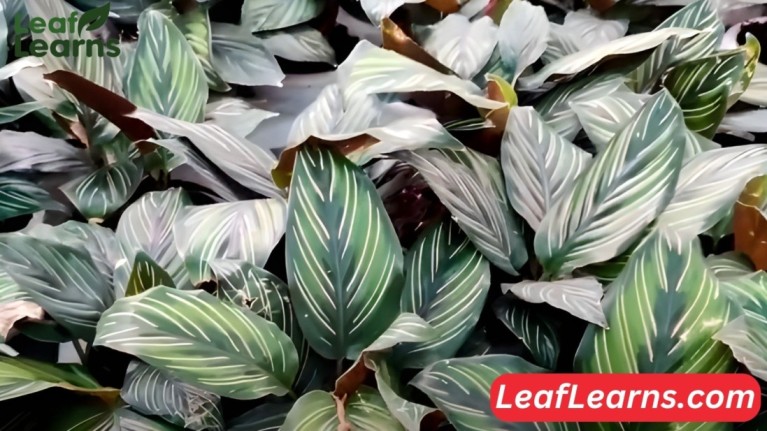
Flowering and Foliage
Though its beautiful leaves are its main attraction, the Beauty Star Calathea can also occasionally provide little white flowers in the spring or summer. These blooms, nevertheless, are not a standout feature and are sometimes overlooked.
The striking foliage is the real star of the show. The luscious emerald green foliage features captivating cream and silver highlights, delicate pink margins, and eye-catching deeper green stripes. In any interior setting, this alluring mix produces a vivid and visually arresting presence.
Appearance and Fragrance
A mesmerizing member of the praying plant family, the Calathea-Beauty Star has gorgeous foliage that brings a hint of the tropics to any interior area. Its elliptical leaves provide a captivating color interplay.
Darker green stripes are adorning the light green backdrop, producing an eye-catching contrast. A hint of elegance is provided by the cream and silver highlights, and a hint of whimsy by the delicate pink margins.
In contrast to a lot of other flowering houseplants, the Calathea Beauty-Star has very little scent. However, its air-purifying properties contribute to a fresher and healthier indoor environment by removing common toxins and pollutants from the air.
Underwatering And Overwatering
- Signs: Wilting leaves, dry and crispy leaf edges, slowed growth.
- Solution: Water the plant thoroughly until water drains from the drainage holes. Allow the top inch of soil to dry before watering again. Increase humidity levels around the plant using a humidifier, pebble tray, or grouping plants together.
Overwatering
- Symptoms include yellowing leaves, mushy stems, growth retardation, and maybe even root rot.
- The answer is to cease watering the soil right away and let it dry up entirely. Repot the plant in a new, well-draining potting mix if the roots seem mushy or discolored. Make sure there are enough drainage holes in the pot. Water the soil just enough to wet it, not so much as to saturate it, by adjusting your regimen.
Common Pests and Diseases
Pests
- Spider mites: These microscopic insects generate stippling or yellowing on the undersides of leaves by weaving small webs. Use neem oil spray or insecticidal soap to treat.
- Mealybugs: These delicate insects resemble cottony white clusters that are visible on stems and foliage. Using an alcohol-soaked cotton swab or insecticidal soap spray, remove them by hand.
- Scale: These armored bugs resemble lumps on stems and foliage. Use neem oil spray or insecticidal soap to treat.
Diseases
- Fungal leaf spot: Leaves may develop brown or black patches due to either too much moisture or inadequate airflow. Enhance ventilation and modify irrigation methods. If required, use fungicide to treat.
- Bacterial leaf rot: On leaves, soft, mushy patches appear, usually beginning at the margins. Improve air circulation and remove any afflicted leaves. Fungicide application may be essential in extreme situations.
Is Calathea Beauty Star toxic to cats and pets?
For homes with curious dogs and cats, the Calathea Beauty Star is non toxic. Unlike many other houseplants, it doesn’t contain any toxic substances that can make pets sick. So, as you take in this plant’s vivid splendor, you can relax knowing that your animal friends are protected.
Toxicity for Human
The good news also applies to family members of humans. The Beauty Star Calathea is an excellent option for households with both adults and children because it is non-toxic to human. You don’t have to worry about ingesting it by mistake, so you may appreciate its presence.
Varieties/Types
Calathea Orbifolia: Large, spherical leaves with stripes of milky white and light green make this relative very attractive. The contrast between them is intriguing.
Calathea Lancifolia: Known by the moniker “Rattlesnake Plant,” this kind has long, lance-shaped leaves with vivid green and yellow patterns that resemble the skin of a serpent.
Calathea Zebrina: This bold beauty boasts dark green leaves adorned with dramatic zebra-like stripes, adding a touch of graphic flair to any room.
Calathea Beauty Star Uses
This fascinating plant is more than simply pretty to look at. With its ability to eliminate harmful toxins and pollutants from your home environment, the Beauty Star Calathea enhances the atmosphere and makes it healthier and more pleasant.
Essential Care Steps for Calathea-Beauty Star
Caring for Beauty Star Calathea involves several essential steps to ensure its health and vitality. General care instructions for this stunning plant include understanding its specific needs, such as proper watering and light requirements.
When it comes to watering, maintaining consistent moisture without overwatering is crucial. Monitoring the soil’s moisture levels and adjusting watering frequency accordingly is key to preventing issues like leaves turning brown, curling, or drooping.
Additionally, being mindful of potential toxicity to cats underscores the importance of choosing safe plants for pet-friendly environments. Propagation and repotting are essential aspects of plant care, offering opportunities for growth and rejuvenation.
Understanding the plant’s unique characteristics, such as its height and perennial nature, can further inform its care routine.
Comparing Calathea-Beauty Star to other varieties like ornata or pinstripe can provide insights into its distinct features and preferences. By incorporating these considerations into its care regimen, enthusiasts can cultivate thriving Calathea Beauty-Star specimens, enjoying their benefits and beauty for years.
FAQs
How do you take care of a Calathea beauty star?
In the spring and summer, provide strong indirect sunshine, regular but not excessive rainfall, well-draining soil, warm temperatures (65–80°F), high humidity (50–60%), and sporadic fertilization.
Is Calathea Beauty Star a prayer plant?
Yes, the Calathea beauty star exhibits nyctinasty, where leaves fold upwards at night, resembling praying hands.
What is the common name for Calathea beauty star?
It is commonly known as the Beauty Star Calathea or Beauty Star Prayer Plant.
Is Beauty Star Calathea indoor or outdoor?
Because it prefers warm temperatures, high humidity, and indirect light conditions that are not usually available outside year-round it grows well indoors.
What is the best soil for Beauty Star Calathea?
Make use of an organic matter-rich, well-draining, aerated potting mix. An excellent combination is perlite, orchid bark, and peat moss.
How big does Calathea beauty star grow?
It typically reaches 12-18 inches tall and 16-24 inches wide.
Is Beauty Star Calathea easy to care for?
It’s not the hardest, but it does need careful consideration of humidity, light, and watering. When weighed against extremely low-maintenance plants, it may be deemed fairly tough.
Calathea beauty star leaves turning yellow?
Possible causes include overwatering, lack of light, nutrient deficiency, or incorrect watering technique (e.g., using tap water).
Calathea Beauty star leaves turning brown?
Underwatering, low humidity, excessive sunlight, or pest infestation could be the culprits.

